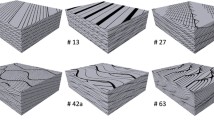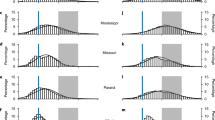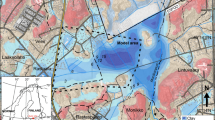Abstract
Deep-water deposits may be defined in terms of ‘architectural elements’ (cf. fluvial models of Miall 1985). In fluvial sedimentology, Miall’s (1985) ‘architectural elements’ are characterized by facies associations and three-dimensional geometry (including orientation). The identification of depositional geometry requires the classification of a hierarchy of bounding surfaces, an approach now widely accepted for fluvial and eolian deposits. Using a hierarchy of bounding surfaces, together with facies analysis and geometry, it is shown how ‘architectural element analysis’ may be used as an aid in the interpretation of deep-water systems and their depositional history.
Access this chapter
Tax calculation will be finalised at checkout
Purchases are for personal use only
Preview
Unable to display preview. Download preview PDF.
Similar content being viewed by others
References
Allen, J.R.L. 1982. Sedimentary structures: their character and physical basis. Developments in Sedimentology 30 (Parts I and II). Elsevier, Amsterdam, 593 and 663 pp., respectively.
Allen, J.R.L. 1983. Studies in fluviatile sedimentation: bars, bar-complexes and sandstone sheets (low-sinuosity braided streams) in the Brownstones (L. Devonian), Welsh Borders. Sedimentary Geology, 33, 237–293.
Armentrout, J.M., Malecek, S.J., Fearn, L.B., Sheppard, C.E., Naylor, P.H., Miles, A.W., Desmarais, R.J. and Dunay, R.E. 1993. Log-motif analysis of Paleogene depositional systems tracts, Central and Northern North Sea: defined by sequence stratigraphic analysis. In: Parker, J.R. (ed.) Petroleum Geology of Northwest Europe: Proceedings of the 4th Conference. The Geological Society, London, pp. 45–57.
Brookfield, M.E. 1977. The origin of bounding surfaces in ancient aeolian sandstones. Sedimentology, 24, 303–332.
Bridge, J.S. and Leeder, M.R. 1979. A simulation model of alluvial stratigraphy. International Association of Sedimentologists, 26, 617–644.
Clark, J.D., Kenyon, N.H. and Pickering, K.T. 1992. Quantitative analysis of the geometry of submarine channels: Implications for the classification of submarine fans. Geology, 20, 633–636.
Clayton, C.J. 1992. Contrasting sediment gravity flow processes in the Late Llandovery, Rhuddnant Grits turbidite systems, Welsh Basin. Geological Magazine.
Damuth, J.E. 1975. Echo-character of the Western Equatorial Atlantic floor and its relationship to the dispersal and distribution of terrigenous sediments. Marine Geology, 18, 17–45.
Damuth, J.E. 1980. Use of high-frequency (3.5–12 kHz) echograms in the study of deep-bottom sedimentation processes in the deep-sea: A review. Marine Geology, 38, 51–75.
Den Hartog Jager, D., Giles, M.R. and Griffiths, G.R. 1993. Evolution of Paleogene submarine fans of the North Sea in space and time. In: Parker, J.R. (ed.) Petroleum Geology of Northwest Europe: Proceedings of the 4th Conference. The Geological Society, London, pp. 59–71.
Droz, L. and Beilaiche, G. 1985. Rhone deep-sea fan: morphostructure and growth pattern. The American Association of Petroleum Geologists Bulletin, 69, 460–479.
Einsele, G. 1985. Responses of sediments to sea-level changes in differing subsiding storm-dominated marginal and epeiric basins. In: Bayer, U. and Seliacher, A. (eds) Sedimentary and Evolutionary Cycles. Springer-Verlag, Berlin, pp. 68–112.
Einsele, G., Ricken, W. and Seilacher, A. (eds) 1991. Cycles and Events in Stratigraphy. Springer-Verlag, Berlin, 955 pp.
Fisher, R.V. 1983. Flow transformations in sediment gravity flows. Geology, 11, 273–274.
Friend, P.F. 1983. Towards the field classification of alluvial architecture or sequence. In: Collinson, J.D. and Lewin, J. (eds) Modern and Ancient Fluvial Systems. International Association of Sedimentologists Special Publication, 6, 345-354.
Friend, P.F., Slater, M.J. and Williams, R.C. 1979. Vertical and lateral building of river sandstone bodies, Ebro Basin, Spain, Journal of the Geological Society, London, 136, 39–46.
Galloway, W.E. 1989a. Genetic stratigraphic sequences in basin analysis I: Architecture and genesis of flooding-surface bounded depositional units. The American Association of Petroleum Geologists Bulletin, 73, 125–142.
Galloway, W.E. 1989b. Genetic stratigraphic sequences in basin analysis II: Application to northwest Gulf of Mexico Cenozoic basin. The American Association of Petroleum Geologists Bulletin, 73, 143–154.
Galloway, W.E., Garber, J.L., Xijin Liu and Sloan, B.J. 1993. Sequence stratigraphic and depositional framework of the Cenozoic fill, Central and Northern North Sea Basin. In: Parker, J.R. (ed.) Petroleum Geology of Northwest Europe: Proceedings of the 4th Conference. The Geological Society, London, pp. 33–43.
Ghibaudo, G. 1992. Subaqueous sediment gravity flow deposits: Practical criteria for their field description and classification. Sedimentology, 39, 423–454.
Haq, B.U., Hardenbol, J. and Vail, P.R. 1987. Chronology of fluctuating sea levels since the Triassic. Science, 235, 1156–1167.
Haq, B.U., Hardenbol, J. and Vail, P.R. 1988. Mesozoic and Cenozoic chronostratigraphy and eustatic cycles. In: Wilgus, C.K. et al. (eds) Sea-level Research: An integrated approach. Society of Economic Paleontologists and Mineralogists Special Publication, 42, 71–108.
Hiscott, R.N. 1979. Clastic sills and dikes associated with deep-water sandstones, Tourelle Formation, Ordovician, Quebec, Journal of Sedimentary Petrology, 49, 1–10.
Jenssen, A.I., Bergslien, D., Rye-Larsen, M. and Lindholm, R.M. 1993. Origin of complex mound geometry of Paleocene submarine-fan reservoirs, Balder Field, Norway. In: Parker, J.R. (ed.) Petroleum Geology of Northwest Europe: Proceedings of the 4th Conference. The Geological Society, London, pp. 135–143.
Kolla, V. 1993. Lowstand deep-water siliciclastic depositional systems: characteristics and terminologies in sequence stratigraphy and sedimentology. Bulletin Centres Recherches Exploration-Production Elf Aquitaine, 17, 67–78.
Kolla, V. and Macurda, D.B. Jr. 1988. Sea-level changes and timing of turbidity-current events in deep-sea fan systems. In: Wilgus, C.K., Hastings, B.S., Kendall, C.G. St. C., Posamentier, H.W., Ross, C.A. and Van Wagoner, J.C. (eds) Sea-Level Changes-An Integrated Approach. Society of Economic Paleontologists and Mineralogists Special Publication 42. Tulsa, Oklahoma: The Society of Economic Paleontologists and Mineralogists, pp. 381–392.
Kolla, V. and Perlmutter, M.A. 1993. Timing of turbidite sedimentation on the Mississippi Fan. The American Association of Petroleum Geologists Bulletin, 77, 1129–1141.
McGregor, B.A., Stubblefield, W.L., Ryan, W.B.F. and Twichell, D.C. 1982. Wilmington submarine canyon: a marine fluvial-like system. Geology, 10, 27–30.
McKee, E.D. and Weir, G.W. 1953. Terminology of stratification and cross-stratification. Geological Society of America Bulletin, 64, 381–390.
Miall, A.D. 1985. Architectural-element analysis: A new method of facies analysis applied to fluvial deposits. Earth Science Reviews, 22, 261–308.
Miall, A.D. 1989. Architectural elements and bounding surfaces in channelized clastic deposits: notes on comparisons between fluvial and turbidite systems. In: Taira, A. and Masuda, F. (eds) Sedimentary Facies in the Active Plate Margin. Terra Scientific Publishing Company (TERRAPUB), Tokyo, pp. 3–15.
Miall, A.D. 1992. Exxon global cycle chart: An event for every occasion? Geology, 20, 787–790.
Mitchum, R.M. 1977. Seismic stratigraphy and global changes of sea level, Part 1: Glossary of terms used in seismic stratigraphy. In: Payton, C.E. (ed.) Seismic Stratigraphy-Applications to Hydrocarbon Exploration. American Association of Petroleum Geologists Memoir (Tulsa), 26, 205–212.
Mitchum, R.M., Vail, P.R. and Thompson III, S. 1977. Seismic stratigraphy and global changes of sea level, Part 2: The depositional sequence as a basic unit for stratigraphic analysis. In: Payton, C.E. (ed.) Seismic Stratigraphy-Applications to Hydrocarbon Exploration. American Association of Petroleum Geologists Memoir (Tulsa), 26, 53–62.
Mutti, E. 1977. Distinctive thin-bedded turbidite facies and related depositional environments in the Eocene Hecho Group (south-central Pyrenees, Spain). Sedimentology, 24, 107–131.
Mutti, E. 1985. Turbidite systems and their relations to depositional sequences. In: Zuffa, G.G. (ed.) Provenance of Arenites. NATO Advanced Scientific Institute Series. D. Reidel, Holland, pp. 65–93.
Mutti, E. 1992. Turbidite Sandstones. Agip, Milan, 275 pp.
Mutti, E. and Ricci Lucchi, F. 1972. Le torbidit deH’Apennino settentrionale: introduzione all’analisi di facies. Memoir Society of Geology Italy, 11, 161–199. (English translation by Nilsen, T.H. 1978. International Geological Review, 20, 125-166).
Mutti, E. and Ricci Lucchi, F. 1975. Turbidite facies and facies associations. In: Examples of Turbidite Facies and Facies Associations from Selected Formations of the Northern Apennines. Field trip guidebook A-11, IX International Congress Sedimentologists, Nice, France. International Association Sedimentologists, 21-36.
Mutti, E. and Normark, W.R. 1987. Comparing examples of modern and ancient turbidite systems: Problems and concepts. In: Leggett, J.K. and Zuffa, G.G. (eds) Marine Clastic Sedimentology. Graham and Trotman, London, pp. 1–38.
Mutti, E. and Normark, W.R. 1991. An integrated approach to the study of turbidite systems. In: Link, M.H. and Weimer, P. (eds) Seismic Facies and Sedimentary Processes of Submarine Fans and Turbidite Systems. Springer-Verlag, pp. 75-106.
Newman, M. St. J., Reeder, M.L., Woodruff, A.H.W. and Hatton, I.R. 1993. The geology of the Gryphon Field. In: Parker, J.R. (ed.) Petroleum Geology of Northwest Europe: Proceedings of the 4th Conference. The Geological Society, London, pp. 123–133.
Newton, S.K. and Flanagan, K.P. 1993. The Alba Field: Evolution of the depositional model. In: Parker, J.R. (ed.) Petroleum Geology of Northwest Europe: Proceedings of the 4th Conference. The Geological Society, London, pp. 161–171.
Normark, W.R. 1970. Growth patterns of deep-sea fans. The American Association of Petroleum Geologists Bulletin, 54, 2170–2195.
Normark, W.R., Piper, D.W.J. and Hess, G.R. 1979. Distributary channels, sand lobes, and mesotopography of Navy Submarine Fan, California Borderland, with applications to ancient fan sediments. Sedimentology, 26, 749–774.
Phillips, S. 1987. Dipmeter interpretation of turbidite-channel reservoir sandstones, Indian Draw Field, New Mexico. In: Tillman, R.W. and Weber, K.J. (eds) Reservoir Sedimentology. Society of Economic Paleontologists and Mineralogists Special Publication, 40, 113–128.
Pickering, K.T. 1981. The Kongsfjord Formation — a late Precambrian submarine fan in north-east Finnmark, north Norway. Norges Geologiske Unders0gelse, 367, 77–110.
Pickering, K.T. 1982a. The shape of deep-water siliciclastic systems — a discussion. Geo-Marine letters, 2, 41–46.
Pickering, K.T, 1982b. Middle-fan deposits from the late Precambrian Kongsfjord Formation Submarine Fan, northeast Finnmark, northern Norway. Sedimentary Geology, 33, 79–110.
Pickering, K.T. 1983. Transitional submarine fan deposits from the late Precambrian Kongsfjord Formation submarine fan, NE Finnmark, N. Norway. Sedimentology, 30, 181–189.
Pickering, K.T., Stow, D.A.V., Watson, M.P. and Hiscott, R.N. 1986a. Deep-water facies, processes and models: A review and classification scheme for modern and ancient sediments. Earth Science Reviews, 23, 75–174.
Pickering, K.T., Coleman, J., Cremer, M., Droz, L., Kohl, B., Normark, W., O’Connell, S., Stow, D. and Meyer-Wright, A. 1986b. A high-sinuosity, laterally-migrating submarine fan channel-levee-overbank: results from DSDP Leg 96 on the Mississippi Fan, Gulf of Mexico. Marine Petroleum Geology, 3, 3–18.
Pickering, K.T., Hiscott, R.N. and Hein, F.J. 1989. Deep Marine Environments. Harper-Collins, London, 416 pp.
Postma, G., Nemec, W. and Kleinspehn, K.L. 1988. Large floating clasts in turbidites, a mechanism for their emplacement. Sedimentary Geology, 58, 47–61.
Pratson, L.F. and Laine, E.P. 1989. The relative importance of gravity-induced versus current-controlled sedimentation during the Quaternary along the Mideast U.S. outer continental margin revealed by 3.5 kHz echo character. Marine Geology, 89, 87–126.
Sgavetti, M. 1991. Photostratigraphy of Ancient Turbidite Systems. In: Link, M.H. and Weimer, P. (eds) Seismic Facies and Sedimentary Processes of Submarine Fans and Turbidite Systems. Springer-Verlag, New York, pp. 107–125.
Shanmugam, G. and Moiola, R.J. 1988. Submarine fans: Characteristics, models, classification and reservoir potential. Earth Science Reviews, 24, 383–428.
Smith, R.D.A., Waters, R. and Davies, J. 1991. Upper Ordovician and Lower Silurian turbidite systems in the Welsh Basin. International Sedimentological Congress, Nottingham, Field Trip Guide No. 20.
Stow, D.A.V. 1986. Deep clastic seas. In: Reading, H.G. (ed.) Sedimentary Environments and Facies, 2nd edn. Blackwell Scientific, Oxford, pp. 399–444.
Surlyk, F. 1987. Slope and deep shelf gully sandstones, Upper Jurassic, East Greenland. The American Association of Petroleum Geologists Bulletin, 71, 464–475.
Timbrell, G. 1993. Sandstone architecture of the Balder Formation depositional system, UK Quadrant 9 and adjacent areas. In: Parker, J.R. (ed.) Petroleum Geology of Northwest Europe: Proceedings of the 4th Conference. The Geological Society, London, pp. 107–121.
Twitchell, D.C. and Roberts, D.G. 1982. Morphology, distribution, and development of submarine canyons on the United States Atlantic continental slope between Hudson and Baltimore Canyons. Geology, 10, 408–412.
Van Wagoner, J.C., Posamentier, H.W., Mitchum, R.M., Vail, P.R., Sarg, J.F., Loutit, T.S. and Hardenbol, J. 1988. An overview of sequence stratigraphy and key definitions. In: Wilgus, C.W., Hastings, B.S., Kendall, C.G. St., Posamentier, H.W., Ross, C.A. and Van Wagoner, J.C. (eds). Sea level Changes: An integrated approach. Society of Economic Paleontologists and Mineralogists, Special Publication No. 42, pp. 39-45.
Van Wagoner, J.C, Mitchum, R.M., Campion, K.M. and Rahmanian, V.D. 1990. Siliciclastic Sequence Stratigraphy in Well Logs, Cores and Outcrops: Concepts for high-resolution correlation of time and facies. American Association of Petroleum Geologists Methods in Exploration Series, Tulsa, No. 7, 55 pp.
Vining, B.A., Ionnides, N.S. and Pickering, K.T. 1993. Stratigraphic relationships of some Tertiary lowstand depositional systems in the Central North Sea. In: Parker, J.R. (ed.) Petroleum Geology of Northwest Europe: Proceedings of the 4th Conference. The Geological Society, London, pp. 17–29.
Walker, R.G. 1975. Nested submarine-fan channels in the Capistrano Formation, San Clemente, California. Geological Society of America Bulletin, 86, 915–924.
Walker, R.G. 1978. Deep water sandstone facies and ancient submarine fans: models for exploration for stratigraphic traps. The American Association of Petroleum Geologists Bulletin, 62, 932–966.
Author information
Authors and Affiliations
Editor information
Rights and permissions
Copyright information
© 1995 Springer Science+Business Media Dordrecht
About this chapter
Cite this chapter
Pickering, K.T., Clark, J.D., Smith, R.D.A., Hiscott, R.N., Ricci Lucchi, F., Kenyon, N.H. (1995). Architectural element analysis of turbidite systems, and selected topical problems for sand-prone deep-water systems. In: Pickering, K.T., Hiscott, R.N., Kenyon, N.H., Ricci Lucchi, F., Smith, R.D.A. (eds) Atlas of Deep Water Environments. Springer, Dordrecht. https://doi.org/10.1007/978-94-011-1234-5_1
Download citation
DOI: https://doi.org/10.1007/978-94-011-1234-5_1
Publisher Name: Springer, Dordrecht
Print ISBN: 978-94-010-4539-1
Online ISBN: 978-94-011-1234-5
eBook Packages: Springer Book Archive




